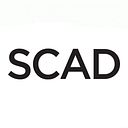The Lines Tell the Story
“Don’t let fear creep into your mind when you set out to paint,” says the man with the brush in his hand.
SCAD painting professor Kent Knowles (B.F.A., painting, 1997) is in a studio at SCADpad West in Atlanta, teaching students from Statesboro to Mexico City to New York and Hong Kong. Knowles is conducting “Drawing with Paint,” an online workshop exploring methods for establishing a focal point within a composition using a single color.
A small mound of burnt sienna oil paint sits next to him, along with mineral spirits and several well-worn brushes. A blank 24x30 canvas stands before him, soon to become an image of a young woman in a winter coat with a large button weighing down her right side. Kent’s camera is positioned close to his canvas, allowing students to see how his arm, wrist, and fingers hold and guide his brush.
“I am not afraid to let the painting come to me,” Knowles says. “I don’t start with an idea. I don’t know what this will become. I let the lines guide me.”
Using his brush to mix a small amount of paint with the mineral spirits, Knowles makes his first vertical stroke. The paint runs in small drips as he makes a second and third stoke. As the drips run together, Knowles scrubs the paint into the canvas, creating earthy brown pockets of color.
A figure slowly emerges from the overlapping lines as Knowles works at extracting the form revealed to him. “This looks like a shoulder, and this an arm,” Knowles observes. “You can see the light must be coming from the right.” He angles his brush as though it were a sun ray beaming onto the figure.
Knowles is himself an acclaimed artist, best known for capturing female subjects in fraught situations. His paintings “High Seas,” “Break Up,” and “Parabola” highlight the strength of women in the face of immediate danger. Snakes, broken ice sheets, and gale force winds are backdrops for his subjects to stand out against.
The son of an Air Force chaplain, Knowles began painting in Germany as a young man and acknowledges Stanley Spencer, Paula Rego and Thomas Hart Benton as major influences. He credits his intuitive process with giving his paintings depth of emotion and capturing the energy of the work.
“The subject will come to life as I refine the lines and see the shapes I have been given.”
Knowles encourages his students to allow their paintings to develop naturally from their point of view: “Your world view is going to help you see what you have in front of you. Don’t be afraid to go for it.”
Throughout the class, Knowles picks up the camera and brings it within inches of the painting. He demonstrates how the mineral spirits help create contrast in face, hair, and coat. He uses a rag to pull color of the canvas and answers questions posted in the “chat.”
The virtual learning environment has facilitated Knowles’ ability to demonstrate the techniques he has honed over decades. His students know this, and eagerly await the next time they are able to see him, singing to himself, sleeves rolled up, wearing a protective mask, an apron, and brandishing his brush with precision as the lines tell him a new story.
See more of Kent’s work here.
By Robert Almand
